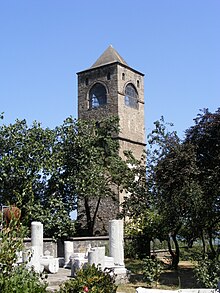This is an old revision of this page, as edited by NeoRetro (talk | contribs) at 08:02, 7 November 2012. The present address (URL) is a permanent link to this revision, which may differ significantly from the current revision.
Revision as of 08:02, 7 November 2012 by NeoRetro (talk | contribs)(diff) ← Previous revision | Latest revision (diff) | Newer revision → (diff)Template:Other uses2 41°00′12″N 39°41′46″E / 41.00333°N 39.69611°E / 41.00333; 39.69611

The Church of Hagia Sophia (Template:Lang-el, meaning "Holy Wisdom" Template:Lang-tr), now the Hagia Sophia Museum, is a former Chalcedonian (Greek Orthodox) church located in the city of Trabzon in the north-eastern part of Turkey. It dates back to the thirteenth century when Trabzon was the capital of the Empire of Trebizond. It is located near the seashore and two miles west of the medieval town's limits. It is one of a few dozen Byzantine sites still existent in the area.

History
Hagia Sophia was built in Trebizond during the reign of Manuel I between 1238 and 1263. After Mehmed II conquered the city in 1461 the church was converted into a mosque and its frescos covered in whitewash. During World War I and for a brief period afterward, the city was occupied by the Russian military and used as a makeshift hospital and depot. Afterwards it was put back into use as a mosque, until 1964 when it was turned into a museum - which it remains to this day. From 1958 to 1964 the frescoes were uncovered and the church consolidated with the help of experts from Edinburgh University and the General Directorate of Foundations.
The Hagia Sophia church is an important example of late Byzantine architecture, being characterised by a high central dome and four large column arches supporting the weight of the dome and ceiling. Below the dome is an Opus sectile pavement of multicolored stones. The church was built with a cross-in-square plan, but with an exterior form that takes the shape of a cross thanks to prominent north and south porches. The structure is 22 metres long, 11.6 metres wide and 12.7 metres tall. The late 13th-century frescos, revealed during the Edinburgh University restoration, illustrate New Testament themes. External stone figurative reliefs and other ornamenting is in keeping with local traditions found in Georgia and Armenia.
24 metres to the west of the church is a tall bell tower, 40 metres high. It was built in 1427 and also contains frescoes.

Gallery
Notes
- Eastmond, Anthony. "The Byzantine Empires in the Thirteenth Century" in Art and Identity in Thirteenth-Century Byzantium: Hagia Sophia and the Empire of Trebizond. Burlington, VT: Ashgate, 2004, p. 1.
Further reading
- Eastmond, Anthony. Art and Identity in Thirteenth-Century Byzantium: Hagia Sophia and the Empire of Trebizond. Burlington, VT: Ashgate, 2004.
External links
- Monasteries of Trabzon
- Hagia Sophia of Trabzon/Trebizond
- Other Christian Churches converted to Mosques
- PontosWorld
- Photos of the Hagia Sophia in Trabzon
- The Church of Hagia Sophia at Trapezounta, Pontos by Dr Constantine Hionides
- 1260s architecture
- Byzantine museums in Turkey
- Byzantine sacred architecture
- Byzantine art
- Empire of Trebizond
- Museums established in 1964
- Architecture in Turkey
- Buildings and structures in Trabzon
- Greek Orthodox churches
- Former church buildings in Turkey
- Cathedrals in Turkey
- Conversion of non-Muslim places of worship into mosques
- Museums in Trabzon Province



